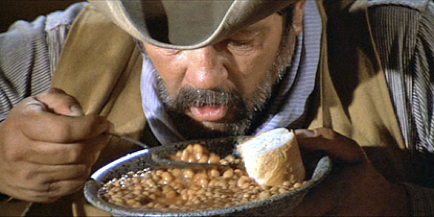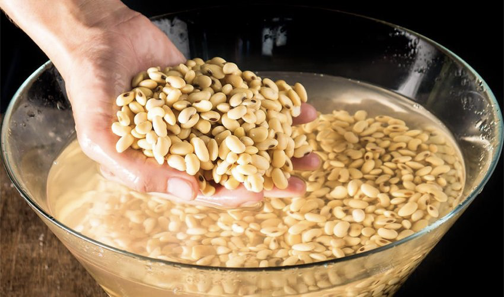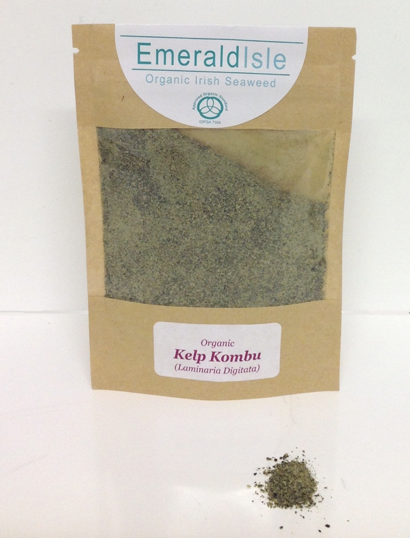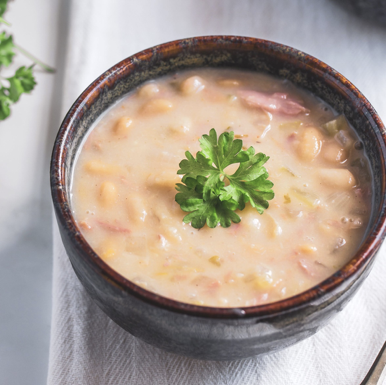NO FEAR Approach to Eating Beans Plus a 100-Year-Old Recipe!
Here’s some very valuable whole-food information regarding BEANS from Meghan Telpner, a Toronto-based best-selling author, speaker, nutritionist, and founder of the Academy of Culinary Nutrition.

Meghan says: “When we welcome the goodness of whole foods into our lives, our bodies refuse to tolerate any old crap we continue to put into them. It's also true that when we rid ourselves of toxins, we can even begin to have reactions to the healthy stuff, too. That's because once the terrain in our bodies is clear, our true food intolerances become illuminated.
“This is where beans come in. It's not that we’re intolerant to them, it's that when our microbiome adjusts and changes, we become more sensitive to some things that never bothered us before. And, very healthy foods, like beans, broccoli, or kale that don't work for even the most iron-clad digestive systems.”

We all know beans and legumes are nutritional powerhouses. They're dense sources of protein, fiber, vitamins, minerals. They can help us feel fuller, support blood sugar balance, improve elimination, and help with weight loss.
And we all know, as well, that they’re notoriously difficult to digest (due to their high protein content and complex carbohydrates). But the basic bean problem is their 'oligosaccharides' (sugars that remain undigested until they get to your colon). It’s with these guys that the bacterial feast begins, and then presto – you're passing gas.
The good news, though: there ARE ways to make beans and legumes more digestible. Here’s how:

USED DRIED BEANS RATHER THAN CANNED. Most canned beans are loaded with salt and bisphenol A, which messes with your endocrine system, amongst other things. Not only are dried healthier because you can control what’s added to them, but they’re cheaper, even if you buy organic.
SOAK BEANS FIRST. Before cooking, soak your beans at least 8 hours (or overnight) or leave them to soak in the morning and cook them when you return in the evening. Soaking beans/legumes reduces the amount of the oligosaccharides that cause gut disruption. This also decreases their phytic acid content, which binds to vitamins and minerals, making them less available for the body to use.

Drain and rinse them. Never simply transfer them with their soaking water into your cooking pot. Using a large colander or strainer, drain, and rinse them really, really, really well. This ensures disposal of all starches or phytates released during their soak.
ADD SEAWEEDS LIKE KOMBU OR KELP to help improve digestibility and increase vitamin and mineral count. Also consider adding spices that aid digestion like fennel, cumin, or ginger.

Finally, PRACTICE MODERATION. Eat your beans in small amounts to give your body time to adjust, and then increase your consumption. You can reap the benefits from even a quarter or a third of a cup. Then pack your plate with plenty of veggie goodness, too.
Cooking with beans is such a terrific way to get more plant-based protein into your diet. If the idea interests you, here’s one of our favorite recipes that I found on www.spruceeats.com that always gets rave reviews:
CLASSIC SENATE BEAN SOUP with ham. It’s been on the menu in the U.S. Senate dining room for over 100 years. It uses inexpensive ingredients, is hearty enough to make a meal, and while it needs a long cooking time, there isn't much work to do.

1 pound dried navy beans (or Great Northern beans)
3 quarts vegetable stock (or broth)
1 ham hocks the meatier, the better
4 tablespoons unsalted butter
2 large onions (peeled and roughly chopped)
4 large celery stalks chopped
4 cloves garlic peeled and chopped
1/2 cup dry white wine
1/2 cup fresh parsley chopped
1 cup mashed potatoes (if in a hurry, substitute 2/3 cup instant mashed potato flakes)
Directions:
Add Recipe to Cook'n

Meghan says: “When we welcome the goodness of whole foods into our lives, our bodies refuse to tolerate any old crap we continue to put into them. It's also true that when we rid ourselves of toxins, we can even begin to have reactions to the healthy stuff, too. That's because once the terrain in our bodies is clear, our true food intolerances become illuminated.
“This is where beans come in. It's not that we’re intolerant to them, it's that when our microbiome adjusts and changes, we become more sensitive to some things that never bothered us before. And, very healthy foods, like beans, broccoli, or kale that don't work for even the most iron-clad digestive systems.”

We all know beans and legumes are nutritional powerhouses. They're dense sources of protein, fiber, vitamins, minerals. They can help us feel fuller, support blood sugar balance, improve elimination, and help with weight loss.
And we all know, as well, that they’re notoriously difficult to digest (due to their high protein content and complex carbohydrates). But the basic bean problem is their 'oligosaccharides' (sugars that remain undigested until they get to your colon). It’s with these guys that the bacterial feast begins, and then presto – you're passing gas.
The good news, though: there ARE ways to make beans and legumes more digestible. Here’s how:

USED DRIED BEANS RATHER THAN CANNED. Most canned beans are loaded with salt and bisphenol A, which messes with your endocrine system, amongst other things. Not only are dried healthier because you can control what’s added to them, but they’re cheaper, even if you buy organic.
SOAK BEANS FIRST. Before cooking, soak your beans at least 8 hours (or overnight) or leave them to soak in the morning and cook them when you return in the evening. Soaking beans/legumes reduces the amount of the oligosaccharides that cause gut disruption. This also decreases their phytic acid content, which binds to vitamins and minerals, making them less available for the body to use.

Drain and rinse them. Never simply transfer them with their soaking water into your cooking pot. Using a large colander or strainer, drain, and rinse them really, really, really well. This ensures disposal of all starches or phytates released during their soak.
ADD SEAWEEDS LIKE KOMBU OR KELP to help improve digestibility and increase vitamin and mineral count. Also consider adding spices that aid digestion like fennel, cumin, or ginger.

Finally, PRACTICE MODERATION. Eat your beans in small amounts to give your body time to adjust, and then increase your consumption. You can reap the benefits from even a quarter or a third of a cup. Then pack your plate with plenty of veggie goodness, too.
Cooking with beans is such a terrific way to get more plant-based protein into your diet. If the idea interests you, here’s one of our favorite recipes that I found on www.spruceeats.com that always gets rave reviews:
CLASSIC SENATE BEAN SOUP with ham. It’s been on the menu in the U.S. Senate dining room for over 100 years. It uses inexpensive ingredients, is hearty enough to make a meal, and while it needs a long cooking time, there isn't much work to do.

Classic Senate Bean Soup
Ingredients:
1 pound dried navy beans (or Great Northern beans)
3 quarts vegetable stock (or broth)
1 ham hocks the meatier, the better
4 tablespoons unsalted butter
2 large onions (peeled and roughly chopped)
4 large celery stalks chopped
4 cloves garlic peeled and chopped
1/2 cup dry white wine
1/2 cup fresh parsley chopped
1 cup mashed potatoes (if in a hurry, substitute 2/3 cup instant mashed potato flakes)
Directions:
1. Soak the beans in water overnight. Make sure the beans are covered with a couple of inches of water, as they can expand somewhat.
2. Drain beans.
3. In a heavy-bottomed soup pot, combine the vegetable stock, the drained beans, and the ham hock.
4. Bring to a boil, then reduce heat to a simmer.
5. Simmer, covered, for 2 hours, occasionally skimming off any scum that forms on the surface.
6. In a separate saucepan, heat the butter over a low-to-medium heat.
7. Add the onion, celery, and garlic to the butter and cook for 2 to 3 minutes or until the onion is slightly translucent, stirring more or less continuously.
8. Add the wine and cook for another minute or two or until the wine seems to have reduced by about half.
9. Add the onion mixture, parsley, and the mashed spuds or potato flakes to the soup and simmer for another hour or until the beans are tender.
10. Remove the ham hock, pull the meat off the bone, and chop it up.
11. Return the chopped meat to the soup. If necessary, add more stock or water to the soup to adjust the thickness.
12. Season to taste with kosher salt and white pepper.
TIPS: If you don't want to soak the beans overnight, you can use a quick-soak method. Bring the beans to a boil in a large pot. Take them off the heat and let them stand for 1 hour. Then drain the beans and continue with the recipe.
You can refrigerate leftover soup for up to five days and reheat it in the microwave. You can also make a large batch, portion it and freeze it. The soup will keep in the freezer for three months.
2. Drain beans.
3. In a heavy-bottomed soup pot, combine the vegetable stock, the drained beans, and the ham hock.
4. Bring to a boil, then reduce heat to a simmer.
5. Simmer, covered, for 2 hours, occasionally skimming off any scum that forms on the surface.
6. In a separate saucepan, heat the butter over a low-to-medium heat.
7. Add the onion, celery, and garlic to the butter and cook for 2 to 3 minutes or until the onion is slightly translucent, stirring more or less continuously.
8. Add the wine and cook for another minute or two or until the wine seems to have reduced by about half.
9. Add the onion mixture, parsley, and the mashed spuds or potato flakes to the soup and simmer for another hour or until the beans are tender.
10. Remove the ham hock, pull the meat off the bone, and chop it up.
11. Return the chopped meat to the soup. If necessary, add more stock or water to the soup to adjust the thickness.
12. Season to taste with kosher salt and white pepper.
TIPS: If you don't want to soak the beans overnight, you can use a quick-soak method. Bring the beans to a boil in a large pot. Take them off the heat and let them stand for 1 hour. Then drain the beans and continue with the recipe.
You can refrigerate leftover soup for up to five days and reheat it in the microwave. You can also make a large batch, portion it and freeze it. The soup will keep in the freezer for three months.
Recipe formatted with the Cook'n Recipe Software from DVO Enterprises.
Sources:
- www.newsnetwork.mayoclinic.org
- www.culinarynutrition.com
- www.fanaticcook.com
- www.foodtolive.com
- www.emeraldisleseaweed.com
- www.thespruceeats.com
 Alice Osborne
Alice Osborne
Weekly Newsletter Contributor since 2006
Email the author! alice@dvo.com
